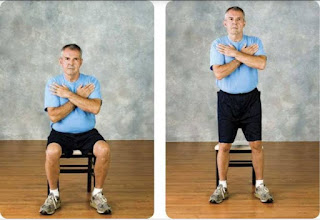FITNESS TEST FOR SENIOR CITIZENS.
Rikli & Jones Test
This test is also known as Fullerton Functional Test of senior citizens. Rikli & Jones were the two persons who developed the Senior citizens test in 2001.
Tests are -:
1. Chair Stand Test -
Procedure : Place the chair against the wall. The participants it's in the middle of the seat. His feet should be shoulder width apart. The arms should be crossed at the wrists and held close to the chest. From the Sitting position the participants should stand up completely and then sit down completely at the start of signal. This is repeated for 30 seconds.
Purpose : The main purpose of this test is to measure lower body strength, particularly strength of legs.
Equipment Required : A chair with the back straight, a stopwatch and a seat of at least 44 cm.
Scoring : The score is total number of completed chairs stands during the given 30 seconds.
2. Arm Curl Test -
Procedure : The participants sits on the chair hold the weight in the hand using a suitcase grip it mean the palm should be facing towards the body. The arm should be in a vertically downward position. The upper arm should not move but lower arm should move freely. Call the arm after complete range of motion gradually keeping the palm up. When arm is lower throat complete range of motion gradually return to the starting position. Maximum number of rounds should be performed in 30 seconds.
Purpose : The main purpose of this test is to assess the upper body strength and endurance which is required for performing household activity.
Equipment Required : A 5 pound weight for women and a 8 pound weight for men, a chair without arms and a stopwatch.
Scoring : The score is total number of arm curls performed within the given 30 second duration.
3. Chair Sit-and-Reach Test -
Procedure : The participants sits on edge of chair. One foot should remain flat on the floor while the other leg should be extended forward with the knee in straight position. Heel should be on the floor and ankle should be bent on 90'. Place one hand on the top of the other with tips of middle fingers at the same level. Instead the participant to inhale and then as he exhales reach forward towards the toes by bending at hip. His back should be straight and head up. Avoid any bounds and never stretch too much. Keep the new straight and hold the reach for 2 seconds.
Purpose : To assess the lower body flexibility which is important for good posture.
Equipment required : Ruler, a chair with straight back.
Scoring : If finger tips touches the toe then score is zero, if they don't touch score would be -ve, if they overlap score will be +ve. The score is noted down to 1/2 inch or 1 cm (either +ve or -ve).
4. Back Scratch Test -
Procedure: The test should be performed in standing position. Keep one hand behind the head and lower it down gently and reach as far as you can. Your palm should touch your body and fingers must be downward. Then carry on other arm behind their back with palm facing outward and fingers facing upward and try to reach up as far as possible in order to touch or overlap the middle finger on the other hand.
Purpose : This test helps to assess upper body flexibility which is essential for a person to perform various job.
Equipment required : A ruler.
Scoring : If the tips meet each other than score is zero, if they overlap score will be+ve, if they don't meet each other than score will be -ve.
5. Eight Foot Up & Go Test -
Procedure : keep a chair next to the wall and place the cone 8 feet away in front of the chair. The participant is initially completely seated hands,resting on the knees and feet flat on the ground. On the command 'go' stopwatch is used and the participant stand and walk as quickly as possible towards the cone, turns around and returns to the chair to sit down.
Purpose : The test is conducted to assess coordination and agility in aged speeds. This helps to evaluate speed and balance of a person while walking or moving.
Equipment required : A chair with straight back, a stopwatch, cone marker, measuring tape.
Scoring : Time is noted down as he sits on the chair. To trials are given for participant, the best trial is recorded to the nearest 1/10th second.
6. Six-minute Walk Test -
Procedure : the walking distance is marked that is 50 yards or 45.72 metre in a rectangular area. Cones are placed at regular intervals to indicate distance covered. Efforts are made to walk maximum distance as quickly as possible in 6 minutes. He may stop any time he desires to do so.
Purpose : This test helps to assess the aerobic fitness of a person.
Equipment required : A measuring tape, stopwatch and cones.
Scoring : The total distance covered in six minutes is recorded to nearest metre.
Top 5 photo editing apps & their ratings click here: Top photo editing apps
Want to know something amazing about space suits, click here: Space suit facts









Comments
Amazing test...
Great information